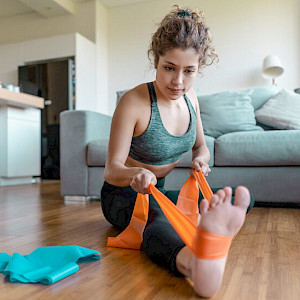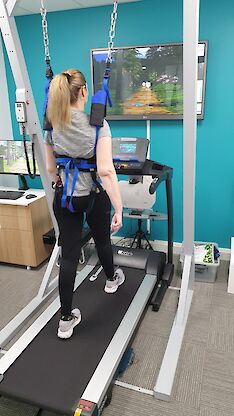Why you should keep moving and stay active with Multiple Sclerosis

Why you should keep moving and stay active with Multiple Sclerosis
Multiple Sclerosis and why it is important to keep moving
Multiple Sclerosis is a chronic, degenerative disease that attacks the central nervous system. The disease can cause a wide range of symptoms, including problems with vision, balance, muscle control, and fatigue. Although there is no cure for Multiple Sclerosis, research has shown that staying active can help to slow the progression of the disease and improve quality of life.
Exercise is an important part of staying active with Multiple Sclerosis. Moderate exercise can help to improve muscle strength and stamina, while also reducing fatigue. Exercise has also been shown to help improve cognition and mood in people with MS.
Starting an exercise program may seem daunting, but it is important to remember that even small amounts of activity can have benefits.
People with MS can exercise, but it is important to check with your doctor before starting a new exercise program. Your doctor will likely want to rule out any other health issues that may be contributing to your symptoms.

Tips for Getting Started: Offer tips for getting started with an exercise program
Tips for starting and maintaining an exercise routine: Start slow – start with a very small amount of exercise and slowly build up over time. If you have not been active for a long time, try to increase your physical activity by 10 minutes each day. If you are already very active, then try to increase your daily activity by just 5 minutes a day.
The Risks of Inactivity: If you are inactive, your health is at risk. It can lead to increased stress on your heart and lungs, a higher chance of getting diabetes or high blood pressure, and an increased risk of developing cancer. You also may be less likely to live as long as someone who exercises regularly.
The Benefits of Exercise Exercising regularly can: increase your energy make you feel less stressed improve your mood help you sleep better strengthen your muscles improve your balance and coordination relieve muscle and joint pain give you more energy help you lose weight or maintain a healthy weight lower your blood pressure protect against heart disease help you avoid diabetes give you more self-confidence prevent some forms of cancer improve your sex life help you live longer

Possible Benefits of exercise for people with Multiple Sclerosis:
Some research suggests that exercise may be able to reduce MS-related fatigue, improve mood and sense of well-being, and improve your balance, coordination, muscle strength, and endurance during daily tasks. It is also believed to improve your sleep quality and ability to complete tasks alone, improve bladder and bowel control, and prevent osteoporosis (bone density loss).
The key to completing an exercise is to make it FUN! To find an activity that you enjoy. If you hate getting out of bed at 5 a.m. to go for a walk, don't make that your exercise routine. Instead, find a form of exercise that's fun for you. And if you love to dance in some form, but hate walking for exercise, then dance your way to better health! The benefits of exercise are so numerous and well documented, that if you don't have time to exercise, you simply don't have time for anything else. This is where we hope you will agree that Blueprint Podiatry can help!
Blueprint Podiatry unweighting harness:
Our Podiatrists have been helping those with MS for collectively over 28 years, and in that time we noticed that more often than not the patient's full body weight was stunting their rehabilitation activities. Over the course of time, Blueprint Podiatry was able to take delivery of a Podiatry first on the Central Coast. An unweighting harness over our instrumented treadmill that is capable of lifting more than 150kg! This allows us to help patients using reduced body weight.
All of our patients start off at a slow speed, for a short amount of time to get used to the harness to get a baseline of data that the Podiatrists can work with. From that appointment, each Podiatrist will explain how we can help you long-term and provide you with a management plan to go through your personal goals. We often hear after a few visits that the patient is more independently capable around their home, not relying on having to 'Furniture Surf' as much.
Not only can we unweight a patient's body, but we do not have to remove their shoes. This gives us the freedom to walk with the patient and record their gait speed, cadence and step length on our treadmill so we can provide the patient with objective feedback to prove that things are progressing well.
Each patient management plan is specifically configured to their individual needs, some patients need resistance bands added into their program to help propel limbs forward, and some patients even need us to physically move their feet for them. The overall aim of this is to keep the patient moving, reduce stiffness, and move each joint in a greater range than it would normally in a full weight-bearing environment.
Final Thoughts
Multiple Sclerosis is a progressive disease, with the aim of slowing down this process. The brain and spinal cord have no pain sensation, so it is important to ensure that they are not overloaded. We need to remind ourselves that each person is an individual, and will respond differently to exercise. The majority of people with MS suffer from muscle weakness, so they may benefit from resistance-training programs.
These programs should be designed to address specific muscle groups, and they may change as the disease progresses. A resistance-training program should include warm-up and stretching exercises, with a progressive overload scheme that can be monitored by objective measures.
Resistance-training programs should be individualised, and the professional responsible for designing the program should have experience in working with people with MS. It is important to remember that the intensity of exercise must be determined by the patient’s ability, and not by their desire for a high level of activity.
For more information or to book an appointment please contact us on 02 43194004.